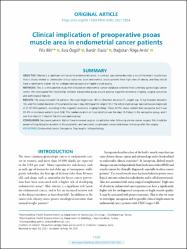Clinical implication of preoperative psoas muscle area in endometrial cancer patients
Künye
Bilir, F., Özgül, E., Elaziz, B., & Arıöz, D. T. (2021). Clinical implication of preoperative psoas muscle area in endometrial cancer patients. Revista da Associação Médica Brasileira, 67, 1759-1763.Özet
OBJECTIVE:
Obesity is a significant risk factor for endometrial cancer. In contrast, sarcopenia describes a loss of the body’s muscle mass that is closely related to unfavorable clinical outcomes. Even endometrial cancer patients have high rates of obesity, and they should have a significantly higher risk for undiagnosed sarcopenia or fragile muscle quality.
METHODS:
This is a retrospective study that included an endometrial cancer database collected from a tertiary gynecologic cancer center. We investigated the relationship between preoperative psoas muscle area by magnetic resonance imaging, surgical outcomes and pathological features.
RESULTS:
The study included 116 patients, the mean height was 160 cm (Standart deviation 7), weight was 72 kg (Standart deviation 18), and the median duration of hospitalization was 4 days (Interquartile range 2–9) in the whole study group. Sarcopenia was diagnosed in 25 (21.6%) patients, according to the magnetic resonance imaging findings. Three (6.5%) obese patients had sarcopenia, but it was 31.4% in nonobese patients (p=0.026). The median duration of hospitalization was five days (3–9 days) in the sarcopenia group, and it was four days (2–7 days) in the non-sarcopenia group.
CONCLUSION:
Sarcopenic patients did not have increased surgical complication rates following uterine cancer surgery. We should be aware of hospitalization duration in those patients, and sarcopenic counterparts necessitate longer follow-up after the surgery.
















